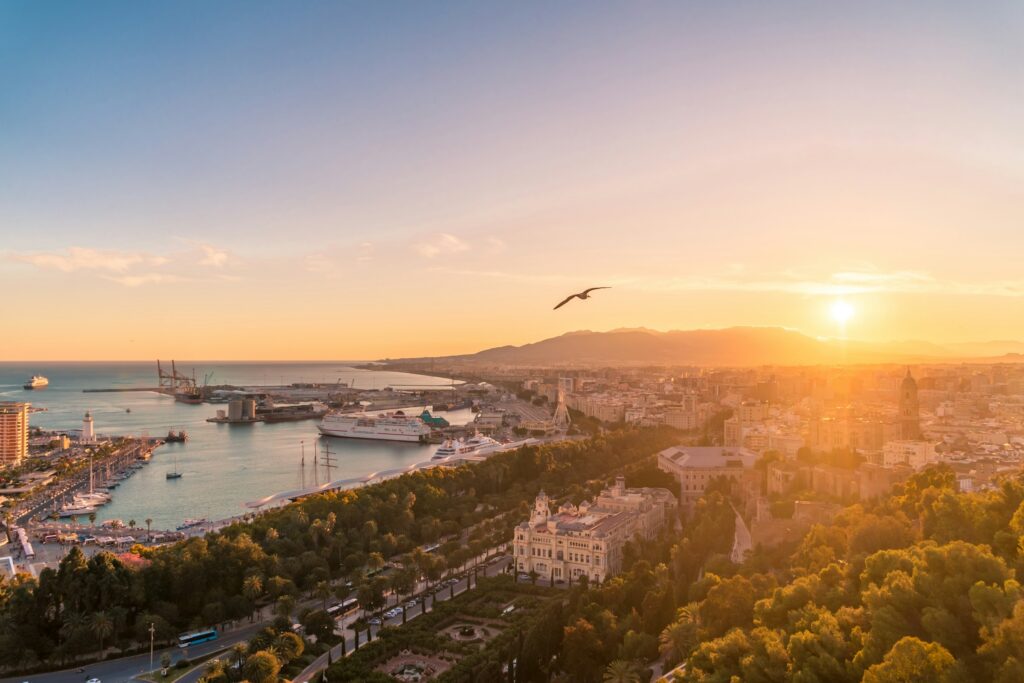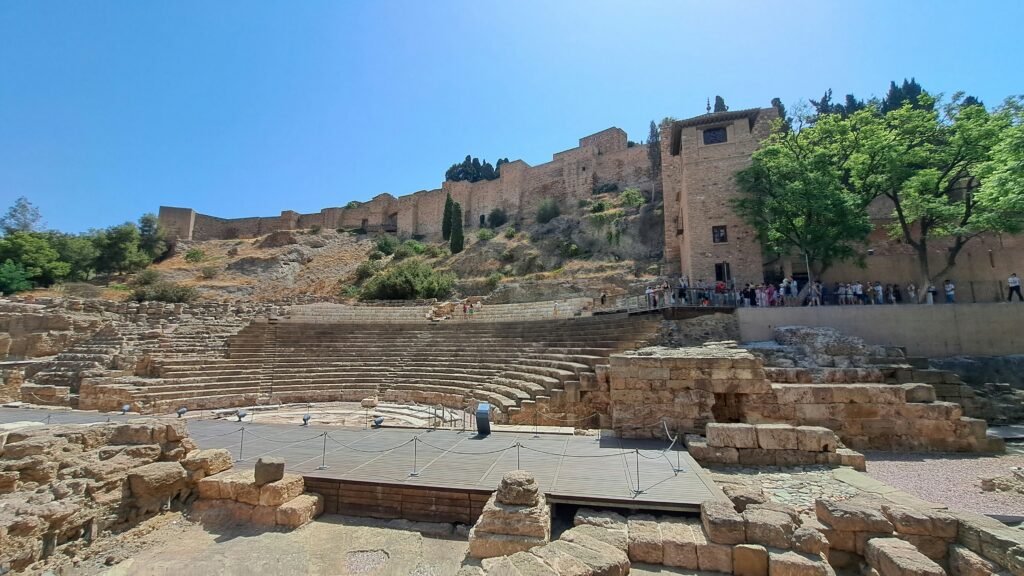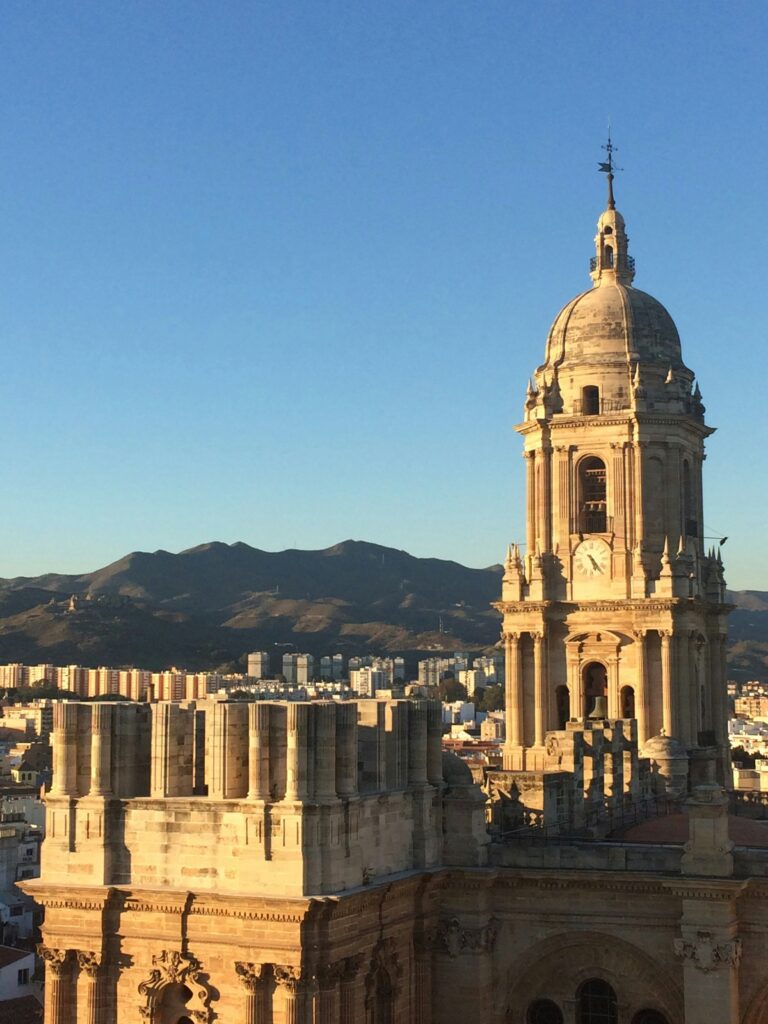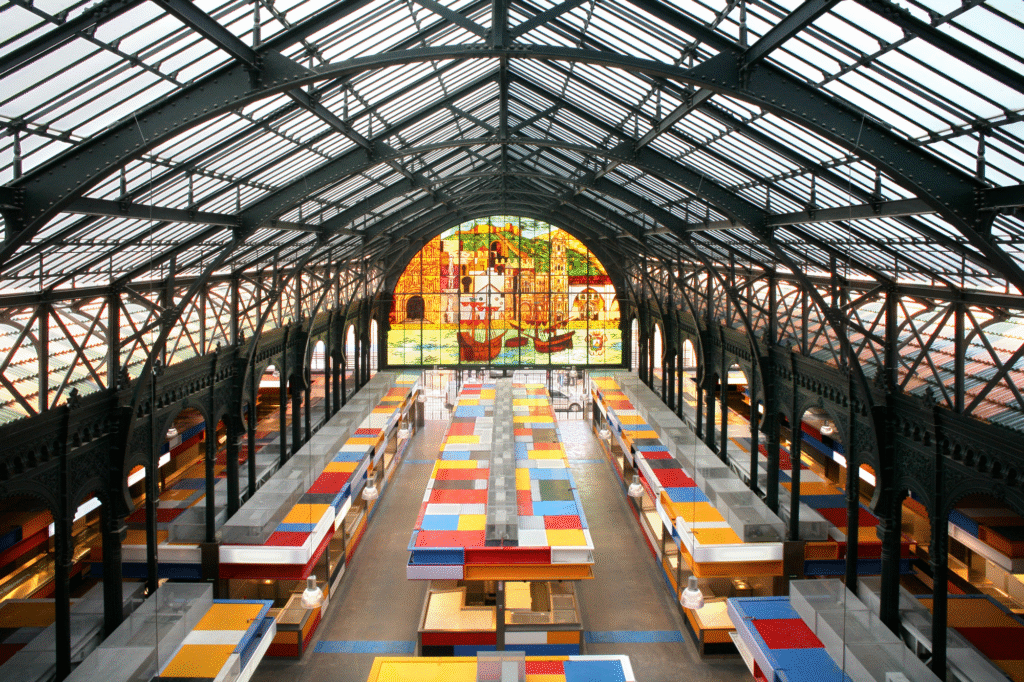Malaga is the second biggest city by population in Andalusia, right after Seville. It’s a city of two worlds: a calm Mediterranean beach town and a historical city with many museums. There are 3000 years of layered heritage here. Like in Seville, it may be hard to figure out what to do in Malaga Spain if you are a first-time visitor. You can sunbathe in the morning, visit a Roman theatre at noon, have skewered sardines at lunch, and end your day with a dinner by the sea with Malaga wine.
Like many other places in Spain, Malaga also has over 300 sunny days a year, so you’ll have good weather whenever you go. But you need to know what matters, what things you can skip, and how to get the most out of your Malaga holiday. There is 14 kilometers of urban coastline, so you can’t see and do everything. It’s also important how long you stay. A weekend? Hot stops are your first choice. A week? Well, you’ve got plenty of time to do day trips from Malaga. I’ll try to cover all the good things and give you a small insight with some Malaga itineraries.

Introduction to Malaga: A Gem on the Costa del Sol
Malaga is small enough that you can get around on foot, and it’s layered enough that every corner has something to notice. It’s a port city, but it doesn’t feel like that. Streets with palm trees, a small but lively old town, and beaches you can get to from most parts of the town with a short walk. That’s why when you are figuring out what to do in Malaga Spain, you need to know what you are looking for from your trip. Beaches? History? Calm? Malaga can cover all.
While doing all that, it’s also important to know when to visit Malaga, know some practical basics like the good areas to walk around and get around, and of course, know the best neighborhoods to take as a base during your visit.
Best Time to Visit Malaga
Malaga works almost year-round, but the time you visit changes what you are going to do in Malaga. July and August are great if you like warm beach days and long evenings. Very hot (sometimes too much, be careful) and no rain at all. But it’s the peak season, it’s crowded and very expensive. Shoulder seasons (April–June and September–October) are the sweet spot. Warm water, fewer tourists, and better deals on hotels and flights. Winter is mild and quiet; it’s cheap and easy if you don’t need to swim. Check those separately if you are aiming for festivals and some lively times. For example, Holy Week happens once a year, and dates change. During those festivals, the city is really nice, though. A lot of energy and fun.
Practical Basics
Cards are widely accepted in cafés and shops, but carry a bit of cash for small buffets or beach snacks. Most stores are open longer than in Western Europe, so don’t worry about shopping. Restaurants generally get crowded after 8 or 9 PM for dinner. Some restaurants close for lunchtime.
Electric plugs, mobile service, and ATMs are easy to find in the centre. For emergencies, the common EU number is useful. Dress casually, but bring good walking shoes because the streets are mostly cobblestones. Keep sunscreen and a reusable water bottle with you.
Best Neighbourhoods to take as a base
You need to choose your accommodation strategically because you want to be close to downtown, but don’t pay a fortune for the hotel or Airbnb. These neighborhoods could be a good base for however long you are going to stay.
- Old Town (Centro Histórico). This is the classic pick. Lanes open into plazas, there’s the cathedral, the Picasso sites, and dozens of tapas bars. You can park yourself here and walk to almost everything. Most of the things about what to do in Malaga Spain are around here.
- Soho & the arts district. Soho is compact and creative (as the name suggests). There are murals, small galleries, independent coffee shops, and a younger vibe. It’s great if you want a neighbourhood with personality that’s still a quick walk to the main sights.
- La Malagueta & the beachfront. Choose this if you want sand and sea steps away. It’s quieter after midnight compared to the Old Town.
- El Perchel / La Trinidad. These areas feel more residential and less polished for tourists. Prices are friendlier, local markets are handy, and you’ll get a slice of how residents live. It’s a short trip into the centre on foot or by tram.

Getting Around in Malaga
Malaga is small. You’ll do most of your sightseeing on foot and can get around the city easily by walking or biking. There are still good metro and bus connections around the city if you want. You can use them for further trips, as well. Taxis and ride-hailing apps are common and affordable for late nights or quick moves. Train services from Maria Zambrano station link Malaga to other Andalusian cities. You are going to take the day trip trains from here. You can also come to the city from the airport easily by train. Tickets are €5 and it takes around 12 minutes. Skip pricey taxis unless you are traveling late at night.
Top Attractions in Malaga – Must See Landmarks in Malaga
Malaga’s top sights, attractions, and must-see landmarks are quite close to each other. They are in a walkable zone, and you can do a few of them together in one day. There are many highlights, and I can’t list them all, but there are highlights. A hilltop castle with views, a fortress with gardens, a cathedral with character, a Picasso museum, and Roman ruins tucked under the Alcazaba. These are the places that answer the question “what to do in Malaga Spain” if you only have time for the essentials.
Since they are close to each other, it will depend on where you are staying and what you like. You can create your list based on that. You probably can’t see them all, so try to be strategic. Select a few you like. If art and history matter, you’ll want Picasso’s museums and the cathedral on your list. If you prefer to move slowly, pick two and spend time in cafés between them.
Alcazaba & Gibralfaro — history and views
Alcazaba is a Moorish citadel with cool courtyards, carved arches, and a quiet place that’s easy to walk through. There are these paths inside that go through the gardens. You can look down at the Roman Theatre from the Alcazaba and climb toward Gibralfaro. The fortress of Gibralfaro is higher on the hill and has great panoramic views of the city and the port. Walking up is straightforward but can be steep. It needs a bit of fitness. A walled path links both sites, so you can do them in one loop.
You may spend half a day or so here. Bring water and a hat. Many people arrive in the morning for cooler temperatures or near sunset for the view. The lower terraces at the Alcazaba, with layers of stone, palm trees, and the theatre below, are great for photos.

Malaga Cathedral — ‘La Manquita’
It took over 200 years to construct the Malaga Cathedral, and the second tower was never finished. That’s why locals call it La Manquita (one-armed lady), and it is right in the middle of the old town. It’s probably also the most popular thing that you’ll find on each what to do in Malaga Spain article. You’ll probably see it every day when you go from one place to another. Make sure to take a visit inside, as well.
Inside is bright and quite calm with high ceilings and carved altars. There is a mix of cultural styles inside, so you can see that even without the audiobook. You don’t have to spend too much time here, and you can take the rooftop walk. The Cathedral’s rooftop is great, since it’s in the middle of the town. Many visitors like the short climb for close-up views of the architecture and a new angle over the city. The area around the cathedral is lively with cafés and shops, so it’s easy to pair the visit with coffee or tapas.

Picasso Museum & Casa Natal
If you don’t know, Picasso was born in Malaga. When you have an artist like this in your history, you have to own it. Malaga keeps that connection very well and with pride. The Picasso Museum contains a range of works that show why he mattered. Early pieces, ceramics, and examples that help you see the arc of his skill. It’s a focused museum: not huge, but thoughtful.
You can also visit the Casa Natal – Picasso’s birthplace. This one is a smaller museum with family history, pictures, and objects. If you like art and Picasso, it could take a few hours to finish both. If not, it could take much shorter.
Roman Theatre
If you’ve been to Alcazaba, you probably have seen the Roman Theatre. It’s under the Alcazaba, and you can quickly glance at it. You can see it from the street, even though it’s small and partly restored. This is one of the rare sights where you can see those layers I mentioned in the beginning. Roman, Moorish, and more modern ones. Roman Theater sits at the very bottom, and it’s only a few stairs upstairs to the Alcazaba to see a different culture. The theatre itself takes just a short stop, but pairs perfectly with the Alcazaba visit.
Other Quick Stops
I’ve covered the biggest ones, but there is much more. Some other quick stops worth a glance: the Centre Pompidou pop-up (bright and modern if you like contemporary art), the Mercado de Atarazanas for a food-market buzz (if markets are your thing, definitely visit), and the small streets off Calle Larios.
These are all compact, close to each other, and great for filling gaps between bigger visits. You may even make bigger trips out of some of them. Like I said, Atarazanas could take quite a bit of time if you like markets. But you can also do these as small stops or as a break between the bigger guns.

Outdoor Adventures, Activities, and Beaches in Malaga
Malaga is not only good for classic beaches, museums, or cultural spaces. You can do some epic outdoor activities and find some solid beaches. From cliffside trails to golden sands, you have to experience Malaga’s nature. You can find something whether you’re a hiker, sun-seeker, or garden lover.
Hike the Caminito del Rey
Caminito del Rey is the go-to dramatic walk near Malaga. This gorge was once seen as the world’s most dangerous hike until its 2015 renovation. There are steel walkways next to the limestone cliffs above turquoise waters. It’s famous because the path clings to steep gorge walls and gives you close-up canyon views without needing technical gear. The track is mostly a boardwalk and path along the cliffside.
Closed-toe shoes are mandatory for the 7.7km route. Take the shuttle from El Chorro station to get you started. Timing also matters. Malaga can get hot, as I said, and if you’re there during these times, you’d prefer the morning or the afternoon. Pictures also look much better. Bring water, sturdy shoes (no flip-flops), sun protection, and a light jacket for the wind through the gorge. You’ll usually need a timed ticket, and it may get sold out, especially in high season, so book in advance. The route is linear, so plan your transport: some people take the shuttle, others use regional trains and buses.
Explore the Botanical Gardens for What to do in Malaga Spain
Malaga’s botanical gardens are a quiet, green alternative to streets and beaches. The main historic garden outside the center is a calm walk with palm trees, tropical plants, and labelled beds. These gardens typically have clear paths, small ponds, and benches where you can sit and read or sketch without noise. Hidden north of the city, La Concepción has over 200 tropical palm species. These spaces are family-friendly and easy on different fitness levels. You can take a short loop or a longer circuit, depending on time. Tickets are usually modest, and some gardens run guided tours that point out rare plants and local history.
Malaga’s Beaches (main picks)
Of course, beaches. Some beaches are amazing. Here are my main picks.
- Playa de la Malagueta: The city’s classic beach, right by the port. Sand, easy access, and plenty of chiringuitos (beachside eateries). It’s great for a quick swim between museum visits and for a sunset stroll.
- Playa de la Misericordia: Wider and quieter than Malagueta, this beach stretches west along the shore. It’s good for longer walks, running, and families who want more space.
- Pedregalejo & El Palo: Two neighboring spots east of the center, known for local seafood and casual bars on the sand. Pick these for a relaxed evening meal by the sea and a less touristy feel.
- Baños del Carmen: A favorite for locals who want a salty, slightly bohemian vibe. It’s not polished, but it’s atmospheric — good for a chilled drink with the sound of waves.
- Guadalmar: Near the airport, this beach has calmer water and a quieter stretch of sand. Good for an easier, less busy beach day.

Day Trips from Malaga
Malaga sits in the middle of one of Spain’s best day-trip playgrounds. In under three hours you can be on a cliff, in a cave, or standing beneath some of Andalusia’s most famous palaces. Since Malaga is a big city – like Seville – you’ll spend enough time to cover the surrounding areas, as well. You should, because Andalusia is pretty nice. Each day trip from Malaga can cover something different, like I said, and you should pick which one you prefer.
A good thing in Spain is that train and bus connections are good. You can take the train to almost all locations you want within Andalusia from Malaga. It’s not expensive and they are modern. Also, combine nearby options: Nerja + Frigiliana or Ronda with nearby white villages. These escapes are one of the best things to do in Malaga for anyone who wants to step outside the city without a long travel day.
Nerja and the caves
Nerja is a good mix of tidy beaches and underground beauties (the caves). The town and Balcón de Europa have good sea views and a friendly seaside vibe if it’s your thing. But the Cueva de Nerja is the real thing with long galleries, huge stalactites, and a feeling like you are on a different planet.
You need to buy a guided tour ticket for the caves. They have regular visiting hours and seasonal schedules; summer has extended opening times while winter has shorter windows. Tickets are normally sold with time slots and can include audio guides or VR extras. Combine a cave visit with lunch in town and a beach hour at one of Nerja’s sandy coves. If you like snorkeling or calm water, some beaches east of the Balcón are quieter and clearer.
Ronda
Ronda is like a postcard. The star is Puente Nuevo, the stone bridge over a gorge with great views. It’s not for everyone. Under the bridge are the old streets and the Plaza de Toros, one of Spain’s oldest bullrings. The city is built on top of a mountain and is divided by the gorge that the Puente Nuevo passes: El Tajo. Getting there takes time, but it’s doable in a day. It can be roughly 1.5 hours by car, depending on traffic; by bus or train, expect closer to two to three hours, depending on connections and schedules.
What to do: walk the bridge and the miradores (viewpoints), poke into the old bullring museum, and wander the steep streets of the old town. Bring layers, the wind in the gorge can feel cooler than the coast.
Granada, Seville, or Córdoba — longer options
These three are the classic heavy hitters. They are the biggest cities in Andalusia, and each needs at least a day if you want a real sense of them. In the case of Seville, you may need a few days to see all the big must-sees. Granada has the Alhambra and hilltop views; Cordoba centers around the Mezquita and flower-filled patios; Seville brings grand plazas, a huge cathedral, and lively neighborhoods.
Travel time from Malaga, Granada, and Cordoba is usually about an hour by train, and Seville is about two hours. All are doable if you start early and book any must-see tickets in advance. I recommend not making a day trip from Malaga to Seville. Go to Seville and stay at least three days (check my five and seven-day itineraries as well) because otherwise you won’t see anything, and it’s wasted time. Cordoba and Granada could be nice, though.
Festivals and Events in Malaga
When you have a city full of sunshine, beaches, good food, and drinks, you have to celebrate it. Malaga does that well. I feel it’s even better than Seville. If you are flexible on dates and try to figure out what to do in Malaga, try to go to Malaga at a time when there is a festival. It’s really fun. The city truly comes alive during its legendary festivals. Locals put a lot of effort into preparing for them.
Feria de Agosto
Feria de Agosto (Malaga Fair) is the city’s big summer party. The party has everything: fireworks, flamenco dresses, improvised street dancing, fairground rides, and non-stop music. It usually runs for a full week in mid-August, and it happens generally 24/7. Start on the old town’s streets and then move to the fairground at night. If you time your trip to Feria, plan ahead for accommodation and expect very full restaurants. If you prefer calm, avoid traveling during this festival. Also, hotels and prices spike, and it’s extremely crowded.
Semana Santa
If you read my Seville or other Andalusia articles, you probably saw Semana Santa there. That’s because this is a Spain-wide event that happens in Malaga, too. Semana Santa (Holy Week) is one of Spain’s most striking traditions, and Malaga’s version is really cool. The week runs from Palm Sunday to Easter Sunday, and you can see parades moving through the city with large religious floats (pasos), brass bands, and brotherhoods in traditional robes.
If you visit Semana Santa, be prepared for long routes, high noise levels, and several hour-long parades. Stand quietly during significant moments, avoid using flash photography when asked, and give space to participants.
Malaga Film Festival
The Festival de Málaga is the city’s annual film festival focused on Spanish and Ibero-American cinema. It usually takes place in late winter or early spring and fills cinemas across the center with premieres, panel talks, and parallel activities. For film lovers, it’s a compact and friendly festival. One of the good things is that screenings are easy to reach on foot, and the program mixes big premieres with smaller, regional films.
Tickets for popular screenings can sell quickly, and the festival often runs workshops or industry events that you can book in advance. Even if you don’t catch a premiere, the festival vibe brings extra screenings, pop-up talks, and occasional outdoor showings. It’s a good pick if you want a cultural angle on what to do in Malaga, which is quieter than Feria but more contemporary than Semana Santa.
Conclusion
Malaga is a city of a lot of things – full if things to figure out what to do in Malaga Spain. Beaches, history, festivals, drinks, and good food. With over 300 sunny days a year, it’s a no-brainer to visit if you are going to be around Andalusia. Because it has a lot of things, it’s hard to figure out what to do in Malaga Spain. You can hike the Caminito del Rey, try the local foods at the Atarazanas Market, or have a beach day at Malagueta Beach. It’s a city of at least 3 days if you want to get a good feel for it. The best is for about five or seven days.
Understand the best things to do in Malaga first, figure out what you want to do, and create an itinerary for however long you are going to stay. This what to do in Malaga Spain guide combines all the best part of each possible things to do from cultural visits to the festivals. Your real Malaga travel itinerary will depend on what you want to do.
FAQ
How many days should I spend in Malaga?
If you want to cover most of the what to do in Malaga Spain things, at least three days. Three to four days lets you explore the historic center, museums, and nearby beaches without rushing. Add extra time for day trips!
Is Malaga Cathedral worth visiting?
Absolutely! Known as “La Manquita” (the one-armed lady), its unfinished tower hides breathtaking Renaissance architecture and panoramic rooftop views. You will also find the Malaga Cathedral on each what to do in Malaga Spain articles – so you don’t want to miss that.
Can I do Caminito del Rey in a day?
Yes! This epic cliffside walk is just 1.5 hours from the city. Book tickets early, they often sell out weeks ahead. On a personal opinion, if you have problems finding out what to do in Malaga Spain, do this, whether you like hiking or not. It’s an amazing experience.
When is the best time for festivals in Malaga?
August bursts with Feria de Agosto’s flamenco and fairgrounds, while Semana Santa’s processions light up Easter week. Spring and fall offer ideal weather, too.
Where’s the best view over Malaga?
Gibralfaro Castle’s mirador beats all, but the AC Hotel’s rooftop bar serves cocktails with sunset panoramas of the port and cathedral.
Are there good day trips from Malaga?
Nerja’s caves, Ronda’s cliffside bridge, and Granada’s Alhambra are all under 2 hours away. Rent a car or take direct buses.